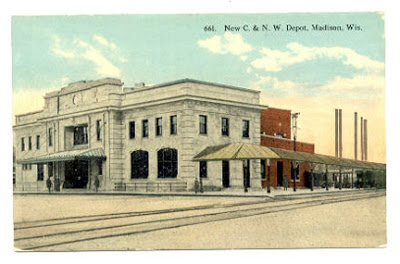Early depots
The first railroad entering Madison was the Milwaukee and Mississippi Railroad, a predecessor of the Milwaukee Road. Their depot was established on the west side of Madison in 1854. [2] The Chicago and North Western constructed a line to Madison in 1864 from the south, crossing Monona Bay. The first passenger station on the site was established in 1871. [3] Due to the proximity of the Milwaukee Road, the C&NW originally wanted to construct a union station in the area. The Milwaukee Road declined and built its own depot nearby, known as East Madison. [4] [5] : 124
Madison eventually became a junction point for the Chicago and North Western, as lines were completed north to Baraboo and Minneapolis. Other lines to Lancaster and Milwaukee were completed in the early 1880s. A new station was completed in the same location in 1885, and included a hotel and dining room within the structure. [4]
Current depot
After the opening of a new Milwaukee Road depot in West Madison, the C&NW made plans for a new larger station, costing $500,000. Leaders in the government of Madison were in support of the plan, but nearby business owners and residents objected. These objections were due to the plan that would close the crossing of Blount Street to allow for expanded platforms. A series of legal proceedings ending up costing 10 years before the C&NW revised plans. [4] [5] : 263
The scaled-down station opened in 1910, at a cost of $250,000, and the Blount Street crossing remains open to this day. [6] A freight depot was also built c. 1908, just northwest of the station. [4] The new station was a success, and was described in 1915 as a "bustling, buzzing, exciting hub of activity." [4] The station served local and named passenger trains, such as the Duluth–Superior Limited, The Mountaineer, and The Viking. [7] The Victory and the Viking, two Chicago-Minneapolis trains, made the trip from Chicago to Madison in a direct line, through Janesville. The Twin Cities 400 from Chicago–Minneapolis used the faster line (compared to the Victory or Viking) through Milwaukee, bypassing Madison to the north, with a connection to the Minnesota 400 at Wyeville. [8]
With the introduction of streamliner trains, Madison was served by the Minnesota 400 , later renamed the Dakota 400,Rochester 400 (later renamed Rochester Special; bound for Mankoto and St. Paul and Minneapolis) and the Duluth-Superior Limited (bound for those cities). At their latter 1940s and 1950s peak, the Minnesota 400 and Dakota 400 went as far west as Rapid City, South Dakota. [9] [10] [11] [12] The station was also used for special trains for University of Wisconsin football games. [4]
Intercity passenger trains in the United States declined after World War II, with fierce competition from the automobile and airplanes. The Rochester 400 made its last run on July 23, 1963. [13] This left Madison with only one C&NW operated train—an unnamed local train to Chicago. [14] This too was discontinued on June 21, 1965. Madison Gas and Electric (MGE) bought the passenger and freight station later that month for $390,000. [15] MGE moved their main offices to the complex in 1983, and renovated the interior, while keeping the exterior facade of the passenger station. [4] The surrounding area was listed as a historic district in 1986, and the property was listed on the Wisconsin State Register of Historic Places in 1989. [4] [16]




